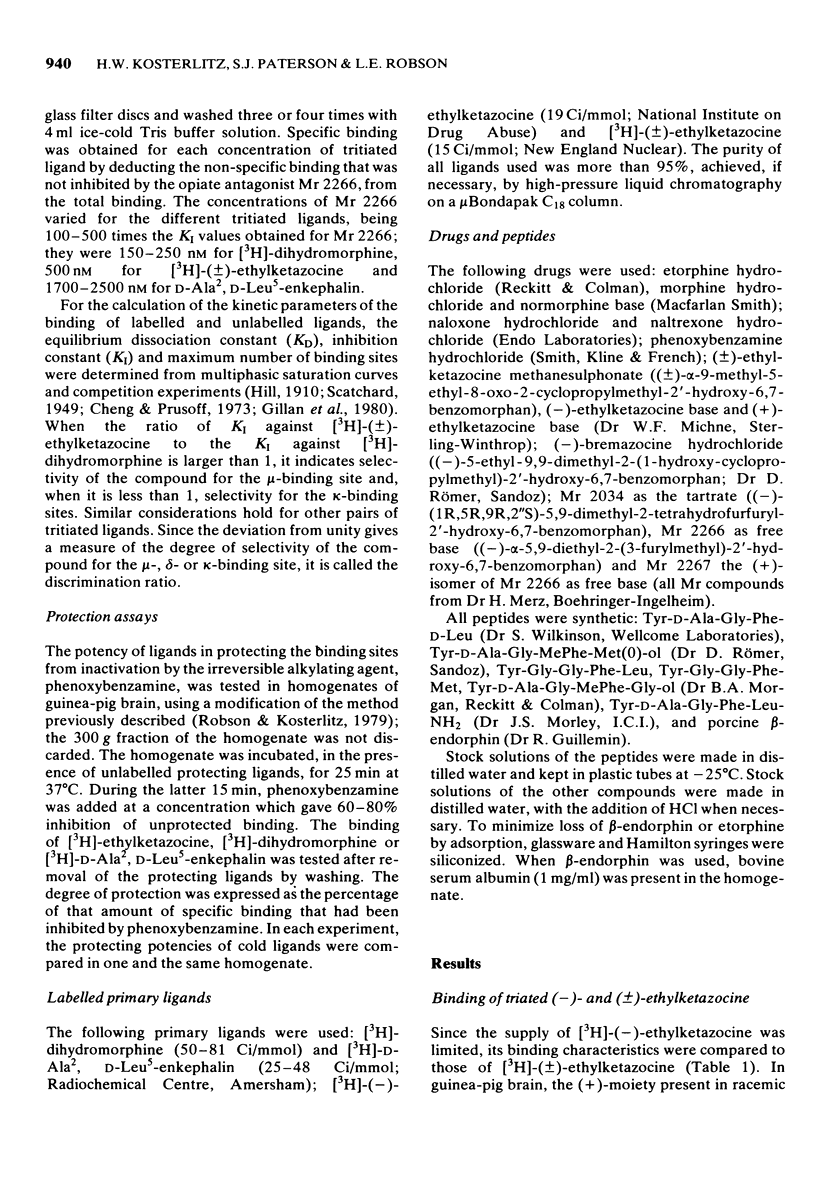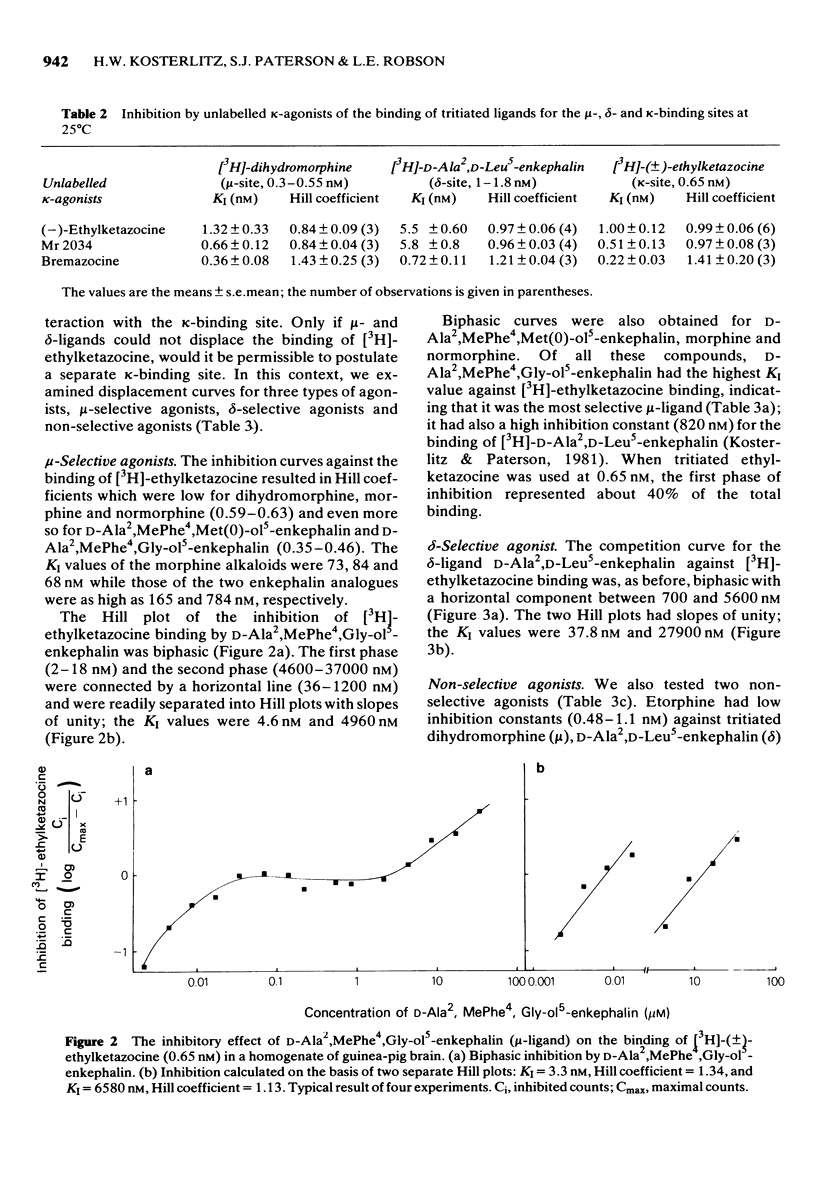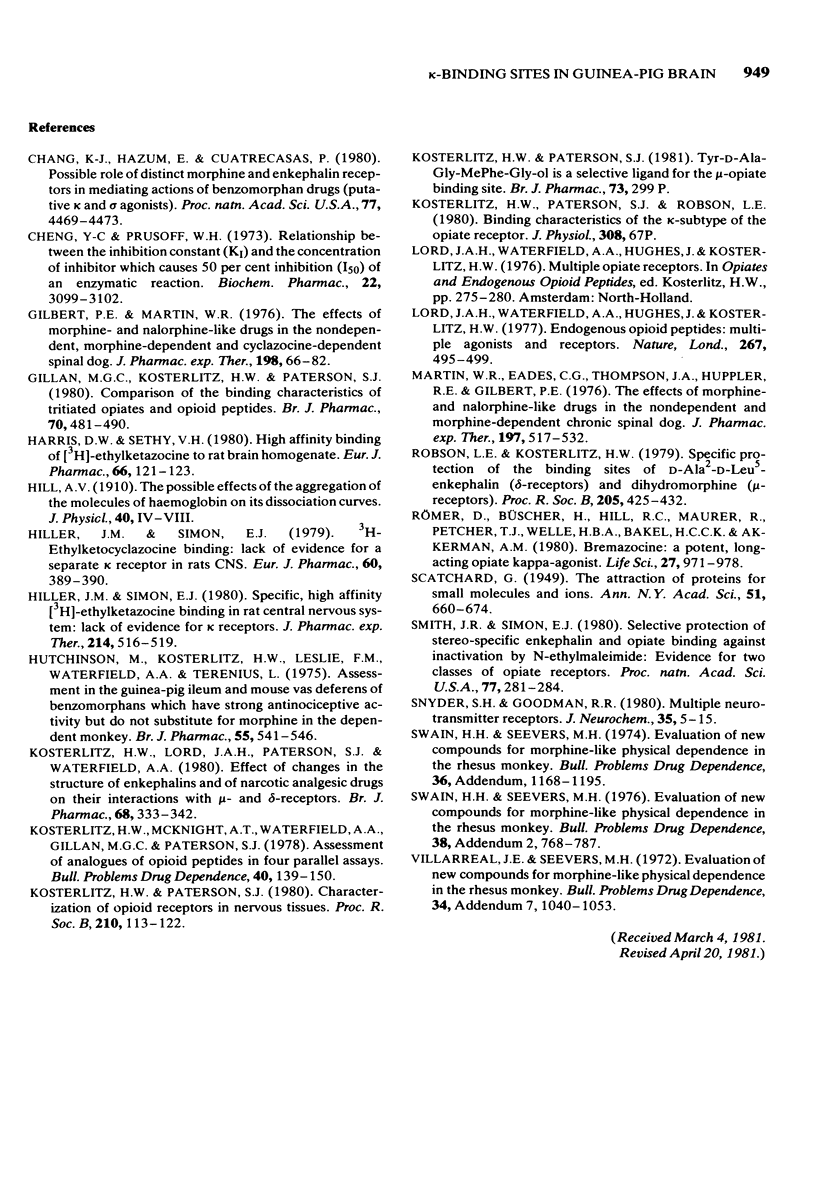Abstract
1. In homogenates of guinea-pig brain, the characteristics of the binding of [3H]-ethylketazocine, an agonist for the putative kappa-receptor, were determined by estimation of the affinity and capacity of binding, by competitive inhibition for the binding site by unlabelled ligands and by selective protection of the binding site from alkylation by phenoxybenzamine. 2. At 25 degrees C the maximum number of binding sites for [3H]-ethylketazocine was about 14 pmol/g fresh brain, of which about 50% were high affinity sites. 3. In competition experiments, the high affinity binding of [3H]-ethylketazocine to the kappa-binding site was readily displaced by several kappa-agonists but not by the selective mu-ligand, D-Ala2, MePhe4, Gly-ol5-enkephalin or the selective delta ligand, D-Ala2, D-Leu5-enkephalin. In contrast, the kappa-agonists tested so far exhibit a high degree of cross-reactivity with the mu-binding site but somewhat less with the sigma-binding site. Similar specificities were observed in protection experiments. 4. The approximate proportions of the three subtypes of opiate receptor in the guinea-pig brain are 25% mu-binding sites, 45% delta-binding sites and 30% kappa-binding sites. 5. The endogenous opioids, Met-enkephalin, Leu-enkephalin and porcine beta-endorphin have only a low affinity for the kappa-binding site.
Full text
PDF










Selected References
These references are in PubMed. This may not be the complete list of references from this article.
- Chang K. J., Hazum E., Cuatrecasas P. Possible role of distinct morphine and enkephalin receptors in mediating actins of benzomorphan drugs (putative kappa and sigma agonists). Proc Natl Acad Sci U S A. 1980 Aug;77(8):4469–4473. doi: 10.1073/pnas.77.8.4469. [DOI] [PMC free article] [PubMed] [Google Scholar]
- Cheng Y., Prusoff W. H. Relationship between the inhibition constant (K1) and the concentration of inhibitor which causes 50 per cent inhibition (I50) of an enzymatic reaction. Biochem Pharmacol. 1973 Dec 1;22(23):3099–3108. doi: 10.1016/0006-2952(73)90196-2. [DOI] [PubMed] [Google Scholar]
- Gilbert P. E., Martin W. R. The effects of morphine and nalorphine-like drugs in the nondependent, morphine-dependent and cyclazocine-dependent chronic spinal dog. J Pharmacol Exp Ther. 1976 Jul;198(1):66–82. [PubMed] [Google Scholar]
- Gillan M. G., Kosterlitz H. W., Paterson S. J. Comparison of the binding characteristics of tritiated opiates and opioid peptides. Br J Pharmacol. 1980 Nov;70(3):481–490. doi: 10.1111/j.1476-5381.1980.tb08727.x. [DOI] [PMC free article] [PubMed] [Google Scholar]
- Harris D. W., Sethy V. H. High affinity binding of [3H]ethylketocyclazocine to rat brain homogenate. Eur J Pharmacol. 1980 Aug 22;66(1):121–123. doi: 10.1016/0014-2999(80)90303-9. [DOI] [PubMed] [Google Scholar]
- Hiller J. M., Simon E. J. 3H-ethylketocyclazocine binding: lack of evidence for a separate kappa receptor in rats CNS. Eur J Pharmacol. 1979 Dec 20;60(4):389–390. doi: 10.1016/0014-2999(79)90249-8. [DOI] [PubMed] [Google Scholar]
- Hiller J. M., Simon E. J. Specific, high affinity [3H]ethylketocyclazocine binding in rat central nervous system: lack of evidence for kappa receptors. J Pharmacol Exp Ther. 1980 Sep;214(3):516–519. [PubMed] [Google Scholar]
- Hutchinson M., Kosterlitz H. W., Leslie F. M., Waterfield A. A. Assessment in the guinea-pig ileum and mouse vas deferens of benzomorphans which have strong antinociceptive activity but do not substitute for morphine in the dependent monkey. Br J Pharmacol. 1975 Dec;55(4):541–546. doi: 10.1111/j.1476-5381.1975.tb07430.x. [DOI] [PMC free article] [PubMed] [Google Scholar]
- Kosterlitz H. W., Lord J. A., Paterson S. J., Waterfield A. A. Effects of changes in the structure of enkephalins and of narcotic analgesic drugs on their interactions with mu- and delta-receptors. Br J Pharmacol. 1980 Feb;68(2):333–342. doi: 10.1111/j.1476-5381.1980.tb10422.x. [DOI] [PMC free article] [PubMed] [Google Scholar]
- Kosterlitz H. W., Paterson S. J. Characterization of opioid receptors in nervous tissue. Proc R Soc Lond B Biol Sci. 1980 Oct 29;210(1178):113–122. doi: 10.1098/rspb.1980.0122. [DOI] [PubMed] [Google Scholar]
- Lord J. A., Waterfield A. A., Hughes J., Kosterlitz H. W. Endogenous opioid peptides: multiple agonists and receptors. Nature. 1977 Jun 9;267(5611):495–499. doi: 10.1038/267495a0. [DOI] [PubMed] [Google Scholar]
- Martin W. R., Eades C. G., Thompson J. A., Huppler R. E., Gilbert P. E. The effects of morphine- and nalorphine- like drugs in the nondependent and morphine-dependent chronic spinal dog. J Pharmacol Exp Ther. 1976 Jun;197(3):517–532. [PubMed] [Google Scholar]
- Robson L. E., Kosterlitz H. W. Specific protection of the binding sites of D-Ala2-D-Leu5-enkephalin (delta-receptors) and dihydromorphine (mu-receptors). Proc R Soc Lond B Biol Sci. 1979 Aug 31;205(1160):425–432. doi: 10.1098/rspb.1979.0076. [DOI] [PubMed] [Google Scholar]
- Römer D., Büscher H., Hill R. C., Maurer R., Petcher T. J., Welle H. B., Bakel H. C., Akkerman A. M. Bremazocine: a potent, long-acting opiate kappa-agonist. Life Sci. 1980 Sep 15;27(11):971–978. doi: 10.1016/0024-3205(80)90107-1. [DOI] [PubMed] [Google Scholar]
- Smith J. R., Simon E. J. Selective protection of stereospecific enkephalin and opiate binding against inactivation by N-ethylmaleimide: evidence for two classes of opiate receptors. Proc Natl Acad Sci U S A. 1980 Jan;77(1):281–284. doi: 10.1073/pnas.77.1.281. [DOI] [PMC free article] [PubMed] [Google Scholar]
- Snyder S. H., Goodman R. R. Multiple neurotransmitter receptors. J Neurochem. 1980 Jul;35(1):5–15. doi: 10.1111/j.1471-4159.1980.tb12483.x. [DOI] [PubMed] [Google Scholar]


